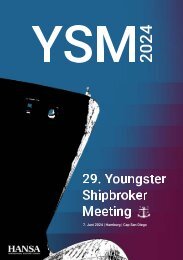HANSA 04-2018
Aktien & Börsen | Marktkompass Offshore | Wasserbau & Planungsrecht | Datenbrillen im Schiffbau | COMPIT 2018 | Fährschifffahrt | Arktische Schifffahrt | Hafnia
Aktien & Börsen | Marktkompass Offshore | Wasserbau & Planungsrecht | Datenbrillen im Schiffbau | COMPIT 2018 | Fährschifffahrt | Arktische Schifffahrt | Hafnia
Sie wollen auch ein ePaper? Erhöhen Sie die Reichweite Ihrer Titel.
YUMPU macht aus Druck-PDFs automatisch weboptimierte ePaper, die Google liebt.
Schiffstechnik | Ship Technology<br />
Source: SSI<br />
Such 3D models are the backbone of<br />
a host of applications from early design<br />
to maintenance of the life-time of a ship.<br />
One of the most popular applications<br />
uses 3D visualizations in Virtual Reality<br />
(VR) or Augmented Reality (AR). Increasingly<br />
realistic computer generated<br />
images can be used for making training<br />
and instructions more intuitive and user-friendly,<br />
ultimately saving time and<br />
cost. VR training applications are akin<br />
to video games – you need to create a<br />
sufficiently large virtual world to make it<br />
interesting, with sufficient level of detail<br />
and behavioural realism and with sufficient<br />
interactivity and training elements<br />
for the player/learner to keep him playing/learning.<br />
And that comes at a hefty<br />
price. Did you know that<br />
high-end video games cost<br />
double-digit millions to produce?<br />
Even if your expectations<br />
are not quite that ambitious,<br />
production costs are<br />
still often prohibitively high<br />
for our industry. This explains<br />
why there are so few<br />
maritime VR training applications<br />
on offer, as found by<br />
Bertram & Plowman (DNV<br />
GL) in their survey. Friedewald<br />
& Meluzov (TU Hamburg-Harburg)<br />
might offer a<br />
silver lining on the horizon<br />
with their work on bringing development<br />
time and cost down, in their case<br />
for Augmented Reality based instruction<br />
modules as intended for ship services and<br />
maintenance.<br />
One Digital Twin to bind them all<br />
COMPIT <strong>2018</strong> in Pavone/Italy<br />
»Let me challenge your design paradigms«,<br />
Day 1: »Game Changers in Design«, »Smart Simulations«,<br />
»Digital Twins, Really?«<br />
»Boldly Exploring Design Spaces«, »Smart Yards«,<br />
Day 2: »Big Data & Machine Learning«, »A Different Game<br />
thanks to VR & Co«<br />
The »Digital Twin« at least sounds like<br />
proper English. And Google gives me<br />
four times as many hits as for Appification.<br />
So, a lot more people use this expression,<br />
but what is it? A 3D geometry model<br />
of a ship is a CAD model. Add information<br />
about steel type, suppliers, inspection<br />
dates, etc. and you get a PDM (product<br />
data model). Add models that mimic<br />
the behaviour (strength, vibration, hydrodynamics,<br />
etc.), and track the changes<br />
of this behaviour over the lifetime of<br />
the ship, and you get a Digital Twin. In<br />
essence, the vision is to have a computer<br />
model with the look and feel of the real<br />
deal. As with Virtual Reality, the vision<br />
is much grander than the reality of current<br />
implementations, but what we have<br />
now is already useful.<br />
Morais et al. (SSI) point out that the<br />
»Digital Twin journey« is a rocky one:<br />
»While the benefits of a digital twin are<br />
real, achieving the desired outcome is<br />
more challenging than generally thought.<br />
Many obstacles, some cultural, some process<br />
related and some technological, commonly<br />
appear when trying to create a digital<br />
twin.« Niepert & Grau (Prostep) show<br />
how a Digital Twin could be used in practice<br />
to accelerate design and production,<br />
describing model-based class approval<br />
and site inspection. Historically, these<br />
processes required numerous drawings,<br />
transferred between classification society<br />
and shipyard. Much time is saved if 3D<br />
models are enhanced by functionalities<br />
such as digital signatures, annotations<br />
that convert directly into data-management<br />
systems, search functions, or digital<br />
highlighting. With 3D PDF, you can<br />
create fully customizable 3D documents<br />
that serve this purpose. And like 2D pdf<br />
documents, the software to read these<br />
documents is widely available and free<br />
of charge.<br />
Aye, aye, A.I.<br />
»Achtung, Baby!«, »Smart Navigation«, »Unmanned Ship<br />
Day 3:<br />
on the Horizon«, »Get Real on Artificial Intelligence«<br />
www.compit.info<br />
Registration to Volker.Bertram@dnvgl.com<br />
One of the often used and rarely understood<br />
buzzwords of recent times is Artificial<br />
Intelligence (AI). The time is ripe<br />
for demystifying it. Bertram (DNV GL)<br />
gives an introduction to key AI technologies<br />
(machine learning, expert systems,<br />
speech and gesture recognition) illustrating<br />
each technique with maritime examples.<br />
The take-home message here is that<br />
there is no need to shiver in awe or fear<br />
that humankind will be eliminated by a<br />
robot revolution. AI is rather an evolution<br />
of engineering tools just as moving from<br />
polynomials to spline curves was when<br />
CAD was in its infant stage. »Just an engineering<br />
tool«, but a powerful one, and<br />
we would be stupid not to embrace the<br />
evolving power of Big Data and machine<br />
learning.<br />
Perez (Sener) outlines his vision for Big<br />
Data and AI based detailed design for<br />
ships, where full-scale performance data<br />
are piped back into design rules which<br />
supplement simulation-based first-principle<br />
design. As Perez admits, »some of<br />
these improvements may seem unrealistic<br />
in the short term, but reality often exceeds<br />
expectations«. And each journey<br />
starts with first steps towards the vision<br />
on the horizon. Woo et al. (Korea Maritime<br />
& Ocean University et al.) have collected<br />
production data from several Korean<br />
shipyards and harvested this wealth<br />
of data to improve the standard information<br />
system for the time factor of process<br />
lead-time. Xie et al. (DNV GL) use artificial<br />
neural nets to find automatically<br />
cracks in the<br />
ship structure on images<br />
from drone-based inspections.<br />
Most applications of<br />
Big Data and machine<br />
learning emerge for ships<br />
in operation, where AIS<br />
data is often used for other<br />
purposes than the original<br />
purpose of increasing<br />
safety in shipping.<br />
Cepeda et al. (COPPE)<br />
use AIS data to estimate<br />
ship emission in the port<br />
<strong>HANSA</strong> International Maritime Journal – 155. Jahrgang – <strong>2018</strong> – Nr. 4 67


















